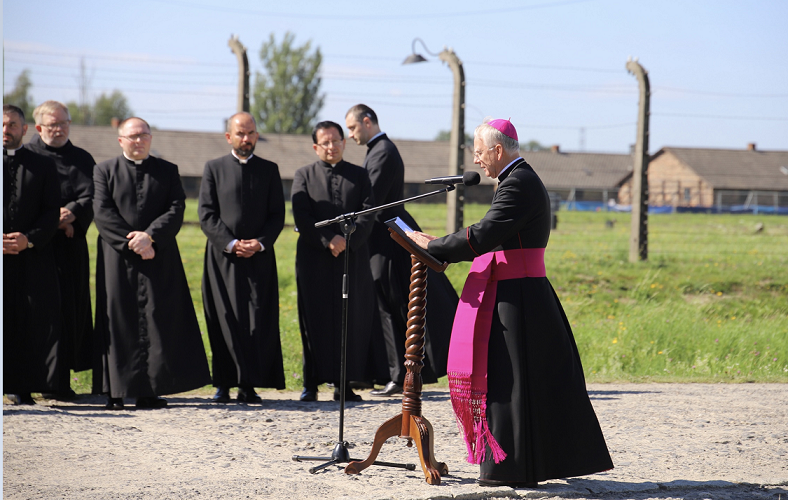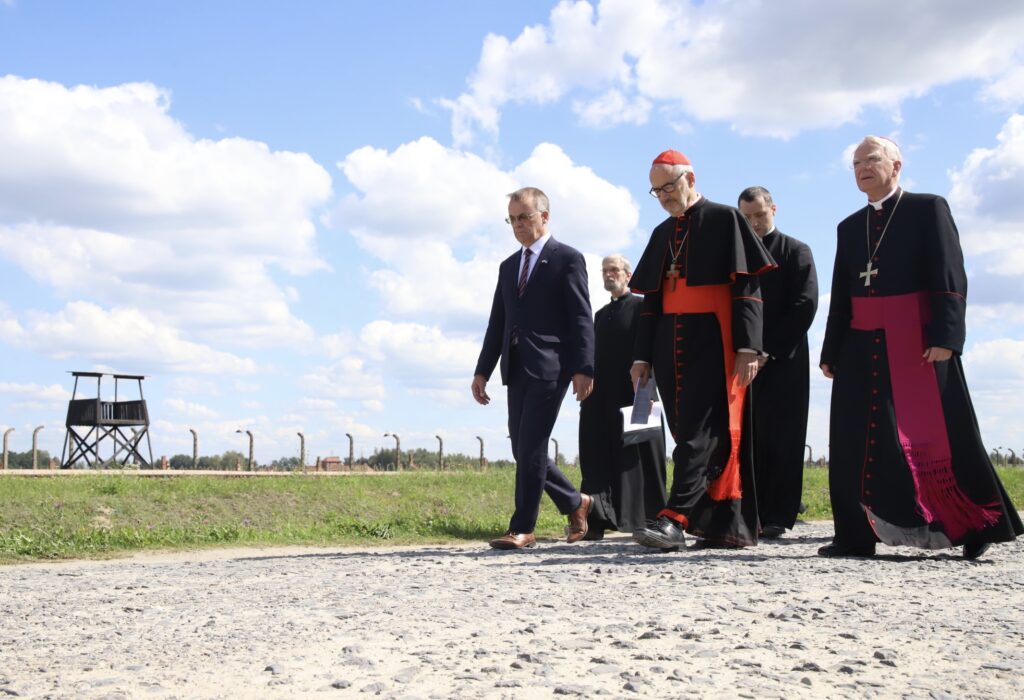Archbishop Marek Jędraszewski on the 80th anniversary of the death of St. Edith Stein, Sr. Teresa Benedicta of the Cross: May our prayer be an important contribution to building a truly fraternal society in Europe


PhotoCredit_Archdiocese of Krakow_Flickr
– Let us now set out on the path that St. Edith Stein, Sr. Benedict of the Cross, traveled as the last in her life, right here in Auschwitz-Birkenau, eighty years ago. May our unified prayer be an important contribution to building a truly fraternal society in Europe, which today, is stricken by a cruel war in Ukraine, caused by a ruthless aggressor which is Russia,” said Archbishop Marek Jędraszewski during a prayer route along the Ramp at the former Auschwitz-Birkenau camp, on the 80th anniversary of the death of St. Edith Stein.
On August 9, the Church remembers St. Edith Stein, Carmelite nun Teresa Benedicta of the Cross, who suffered death in Auschwitz 80 years ago. St. John Paul II declared her the patron saint of Europe in 1999.
The Center for Dialogue and Prayer in Oswiecim has planned the main commemoration of the anniversary of the death of St. Teresa Benedicta of the Cross for this day. During the prayer route, along the Ramp at the former Auschwitz-Birkenau camp, Archbishop Marek Jędraszewski, Metropolitan of Krakow, delivered his word to the gathering on behalf of the Polish Episcopate, and Bishop Bertram Meier of Augsburg on behalf of the German Episcopate.

PhotoCredit_Archdiocese of Krakow_Flickr
Below we publish the full text of the speech by Cracow Metropolitan Archbishop Marek Jędraszewski:
Eighty years ago, on Sunday, August 9, 1942, the prisoner transport from the Drente-Westerbork camp reached its destination. The SS men began to open the so-far-closed carriages, and the Jews who had been arrested in the Netherlands began to emerge onto the railroad ramp at Auschwitz-Birkenau. Among them was Sr. Benedicta of the Cross, Benedicta a Cruce, Edith Stein, along with her own sister Rosa.
For at least a dozen hours, while the train clearly headed east, she had already been fully aware of where she was to arrive and what fate awaited her here – almost in a moment – decreed by the German Nazis. Three days earlier, on August 6, in Westerbork, she had written the last letter of her life, addressed to Mother Ambrosia Antonina Engelmann, the prioress of the Carmel in Echt. In large, uneven, clearly disjointed letters, which undoubtedly indicated her tremendous inner tension, she conveyed a piece of very important information. Right in the second sentence she writes, “Tomorrow one transport will leave early (Silesia or Czechoslovakia??). “Silesia – meaning Auschwitz, or Czechoslovakia – meaning Terezin, to be more precise: Konzentrationslager Theresienstadt. Auschwitz meant immediate death in the gas chambers while the ghetto in Terezin offered little chance of survival, but it certainly postponed the day of execution. In any case, both options – Auschwitz or Theresienstadt – meant the same: one last journey toward the end of life.
For Edith Stein that journey began, according to an eyewitness to these events at the Westerbork camp, Father Ignatius Bromberg, “early in the morning at sunrise on August 7. Along the road that ran across the camp stood a long line of men, women and children. Among the people, monastic garb stood out peculiarly. The place of the gendarmes was taken by armed SS men, and amid their crude and coarse orders this long snake of people left the camp. We who remained still waved our hands for a long time! This was the last time we saw this transport”.
Only a few traces remain from that journey. First, a lady on the station platform in Schifferstadt, near Ludwigshafen, heard someone call her by her maiden name. She was Edith’s former teacher, Miss Dr. Stein, dressed in black. Edith said to her through a barred window of her train carriage: “Please, greet the sisters at St. Magdalene’s – I’m on my way east”. The last trace was a pencil-written card received by Sr. Adelgunda Jaegerschmid from St. Lioba in Freiburg, which read, “Greetings from the road to Poland. Sister Teresa Benedicta”.
These brief sentences: “I’m on my way east”, “I’m going to Poland” in this case sounded unequivocal: “I’m going to Auschwitz,” “I’m going to death.” Saying this through the window of her train car, she “appeared to be a calm and good person.” Probably, too, in her prayers at the time, she begged God to remain faithful to the end to those words, which on Passion Sunday, March 26, 1939, less than two weeks after the fall of Czechoslovakia and the occupation of Bohemia and Moravia by Hitler’s Third Reich, she addressed to m. Ottilia Thannisch OCD, prioress of the Carmel in Echt: “Dear Mother, please allow me to give myself to the Heart of God in an atoning sacrifice for the intention of true peace, so that God would break the reign of Satan without a new world war and a new order would prevail.” Edith Stein referred to these words more than two months later, in a testament written in the octave of Corpus Christi 1939: “I already accept death as God has predestined for me, with perfect submission to His will and with joy. I ask the Lord to be willing to accept my life and death for His honor and glory, for all the concerns of the Sacred Heart of Jesus and Mary, for the Holy Church, … to plead for the rescue of Germany, for the peace of the world, and finally for my loved ones living and dead, for all whom God has given me, so that none of them may perish.”
Her testament explains why Wielek, a Dutch official in Westerbork who was still trying to save her from inevitable transportation, was told firmly: “No, please don’t do anything. Why any exception for me or this group? Isn’t justice precisely about not drawing any privileges from my baptism? If I can’t share the fate of my brothers and sisters, my life is as if destroyed.”
In addition to solidarity with her own Jewish people, another extremely important theme of her life shines through in her writings and letters: her union with the mystery of Christ’s Cross. In early 1931, she wrote a reflection entitled The Mystery of Christmas. In it, she strangely linked the mystery of the Incarnation with the mystery of Redemption, which she saw relevant for every true believer: “Every human being must suffer and die, but if he is a living member of the Mystical Body of Christ, his suffering and death acquire redemptive power through the divinity of the One who is its Head. This is the essential reason why every saint so longed for suffering.” And she longed to be a holy nun, totally devoted to her Divine Spouse. At the end of 1941, in a letter to Mother Ambrosia Antonia Engelmann, she wrote: “Scientia Crucis can only be acquired when one has experienced the Cross to its depths. I have been convinced of this from the beginning and said with all my heart: Ave Crux, spes unica! (Hail the Cross, our only hope!)”.
Now, finding herself on the railroad ramp of Auschwitz-Birkenau, Edith Stein, Sr. Benedict of the Cross, was to acquire this Scientia Crucis in an ultimate way. By sacrificing her life for her people, she was, to some extent, following in the footsteps of a man who almost exactly a year earlier had sacrificed his life for an unknown fellow prisoner – only because the man had a wife and children – in the footsteps of Father Maximilian Maria Kolbe. Probably because of the similarity of their fates, so deeply connected to the Scientia Crucis, during the Angelus prayer crowning the canonization ceremony of Edith Stein in Rome on October 11, 1998, Holy Father John Paul II said: “I remember that in 1982, also in October, in this very place I was able to canonize Maximilian Mary Kolbe. I was always convinced that these two martyrs of Auschwitz together would lead us into the future: Maximilian Mary Kolbe and Edith Stein — St Teresa Benedicta of the Cross. Today I am aware that a sort of cycle is being completed. I thank God for this.”
Meanwhile, just a year later, with the Apostolic Letter motu proprio of October 1, 1999, the Holy Father John Paul II, along with St. Brigid of Sweden and St. Catherine of Siena, proclaimed St. Edith Stein as Co-Patroness of Europe. “With Edith Stein,” reads this papal document, “we enter the heart of this tormented century, pointing to the hopes which it has stirred, but also the contradictions and failures (…). In particular, Edith made her own the suffering of the Jewish people, even as this reached its apex in the barbarous Nazi persecution which remains, together with other terrible instances of totalitarianism, one of the darkest and most shameful stains on the Europe of our century. At the time, she felt that in the systematic extermination of the Jews the Cross of Christ was being laid on her people, and she herself took personal part in it by her deportation and execution in the infamous camp of Auschwitz-Birkenau. Her voice merged with the cry of all the victims of that appalling tragedy, but at the same time was joined to the cry of Christ on the Cross which gives to human suffering a mysterious and enduring fruitfulness. (…) Today’s proclamation of Edith Stein as a Co-Patroness of Europe is intended to raise on this Continent a banner of respect, tolerance and acceptance which invites all men and women to understand and appreciate each other, transcending their ethnic, cultural and religious differences in order to form a truly fraternal society. Thus may Europe grow! May it grow as a Europe of the spirit, in continuity with the best of its history, of which holiness is the highest expression.”
Your Eminence, Most Reverend Cardinal Prefect of the Dicastery for Promoting Integral Human Development, Your Excellency, Most Reverend Bishop of Augsburg, Dear Sisters and Brothers, let us now set out on the path that St. Edith Stein, Sr. Benedict of the Cross, traveled as the last in her life, right here in Auschwitz-Birkenau, eighty years ago. May our unified prayer be an important contribution to building a truly fraternal society in Europe, which today, is stricken by a cruel war in Ukraine, caused by a ruthless aggressor which is Russia. May our solidarity-based cry to God for a Europe of the spirit be part of the hymn Juxta crucem tecum stare, written on Good Friday in 1938, in which Edith Stein stated that our being together with Our Lady of Sorrows must consist primarily in contributing to the eternal salvation of others:
“Those, however, whom You have chosen for your retinue,
To one day surround You at the eternal throne,
They must stand here with You under the cross,
They must with the blood of the heart of bitter sorrows
Redeem heavenly glory for souls,
Which the Son of God has left them to inherit.”



Dodaj komentarz